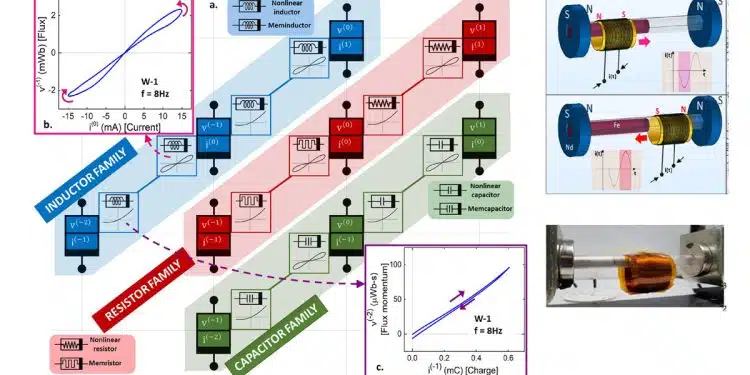Scientists from Texas A&M University Abhiram Dinavahi, Alexandre Yamamoto and H. Rusty Harris described meminductance in their article published by nature.com.
The first intentional memristor was physically realized in 2008 and the memcapacitor in 2019, but the realization of a meminductor has not yet been conclusively reported. In this paper, the first physical evidence of meminductance is shown in a two-terminal passive system comprised primarily of an electromagnet interacting with a pair of permanent magnets.
The role of series resistance as a parasitic component which obscures the identification of potential meminductive behavior in physical systems is discussed in detail. Understanding and removing parasitic resistance as a “resistive flux” is explored thoroughly, providing a methodology for extracting meminductance from such a system.
The rationale behind the origin of meminductance is explained from a generalized perspective, providing the groundwork that indicates this particular element is a realization of a fundamental circuit element. The element realized herein is shown to bear the three required and necessary fingerprints of a meminductor, and its place on the periodic table of circuit elements is discussed by extending the genealogy of memristors to meminductors.
Results and Conclusions
Using the phase difference between the transfer function and the independent state variable to distinguish between an element and its mem-versions provides a new experimental perspective to aid the physical realization of any two-terminal circuit element.
The element realized in this work has been shown to bear the three fingerprints of a meminductor and thus prove the physical evidence of meminductance, albeit overshadowed by a more dominant resistive component. The next step would be to make the series resistance less dominant, so that the element realized would truly be a meminductor without the need to extract hidden meminductive behavior.
Operating the element in a cryogenic environment below the superconducting temperature of the winding appears the most feasible technique to eliminate series resistance in the configuration discussed. At room temperature, combating series resistance would require strengthening the inductive component through higher frequency operation; hence, replacing electromechanical means of varying instantaneous inductance with electronic phenomena is worth pursuing.
Also, several existing physical systems such as solenoid plungers and audio speaker systems share similarities in operation principle with the meminductor described in this work and thus need further work dedicated to closer examination for meminductive properties.
Read the full paper for details: Dinavahi, A., Yamamoto, A. & Harris, H.R. Physical evidence of meminductance in a passive, two-terminal circuit element. Sci Rep 13, 1817 (2023). https://doi.org/10.1038/s41598-022-24914-y






























